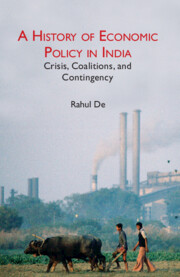Book contents
- Frontmatter
- Contents
- List of Figures and Tables
- Preface
- Acknowledgments
- List of Abbreviations
- Introduction
- 1 Colonialism and the Indian Economy
- 2 The Drive to Industrialize under Nehru's Leadership: 1950–66
- 3 The Turn to Populism under Indira Gandhi: 1967–79
- 4 The Early Liberalization Years: 1980–2003
- 5 Maturity of Reforms in the UPA Years: 2004–13
- 6 Reforms under the NDA Government: 2014–19
- Index
5 - Maturity of Reforms in the UPA Years: 2004–13
Published online by Cambridge University Press: 14 September 2023
- Frontmatter
- Contents
- List of Figures and Tables
- Preface
- Acknowledgments
- List of Abbreviations
- Introduction
- 1 Colonialism and the Indian Economy
- 2 The Drive to Industrialize under Nehru's Leadership: 1950–66
- 3 The Turn to Populism under Indira Gandhi: 1967–79
- 4 The Early Liberalization Years: 1980–2003
- 5 Maturity of Reforms in the UPA Years: 2004–13
- 6 Reforms under the NDA Government: 2014–19
- Index
Summary
How Was the UPA Different from Other Coalition Governments?
The UPA, which formed the central government after elections in 2004, was a unique coalition built on the back of secularist opposition to the BJP government. The INC won slightly more Lok Sabha seats than the BJP but gained powerful coalition partners to get a clear majority. The three largest coalition partners were the left with 43 seats, Uttar Pradesh-based Samajwadi Party with 36 seats, and the Bahujan Samaj Party with 19 seats. A few powerful regional parties also supported the coalition, such as the Telangana Rashtriya Samiti in Andhra Pradesh, the DMK from Tamil Nadu, and the National Congress Party from Maharashtra. Coalition governments had become the norm in the 1990s, but the UPA was different from the earlier coalitions in composition. First, the main opposition party, the BJP, had a significant number of seats which gave more impetus for the coalition members to stick together. Second, few of the coalition members had significant seats in the Lok Sabha, making them an important part of the coalition. Third, the coalition member had different political and ideological stances which meant that there was no straightforward economic plank which they could agree upon. These differences determined the mode of policymaking under the UPA government.
Ruparelia (2005) reviews theories about coalition politics and argues that there is a consensus regarding principles that lead to successful coalitions: parties that share policy goals are more likely to form a coalition, and diverse coalitions that fail to devise explicit pacts to accommodate their differences are vulnerable to sudden events which may trigger their demise. This knowledge may be common sense, but it foregrounds the fact that the UPA coalition was not a match of ideologies or political mandate but one of convenience – based on keeping the BJP out of government. But for the INC, to make the coalition work would require keeping members happy through cabinet berths, including partners in policy discussions and finding a plank on which everyone agrees. The author adds that historical failures of coalition governments – of the Janta Dal in 1977, the V. P. Singh government in 1989, the NDA in 1996 – faced severe cleavages which could not be overcome. In 2009, the UPA came to power again.
- Type
- Chapter
- Information
- A History of Economic Policy in IndiaCrisis, Coalitions, and Contingency, pp. 123 - 150Publisher: Cambridge University PressPrint publication year: 2024



